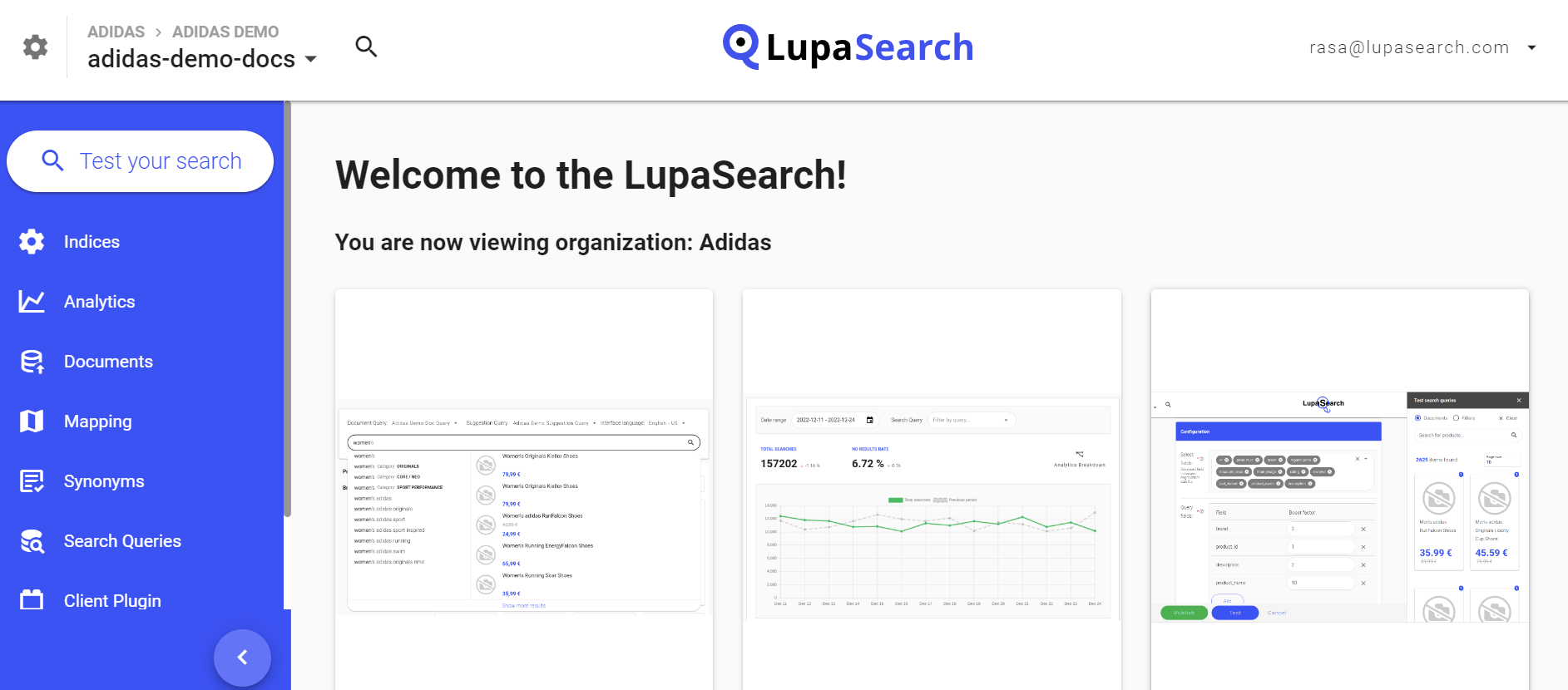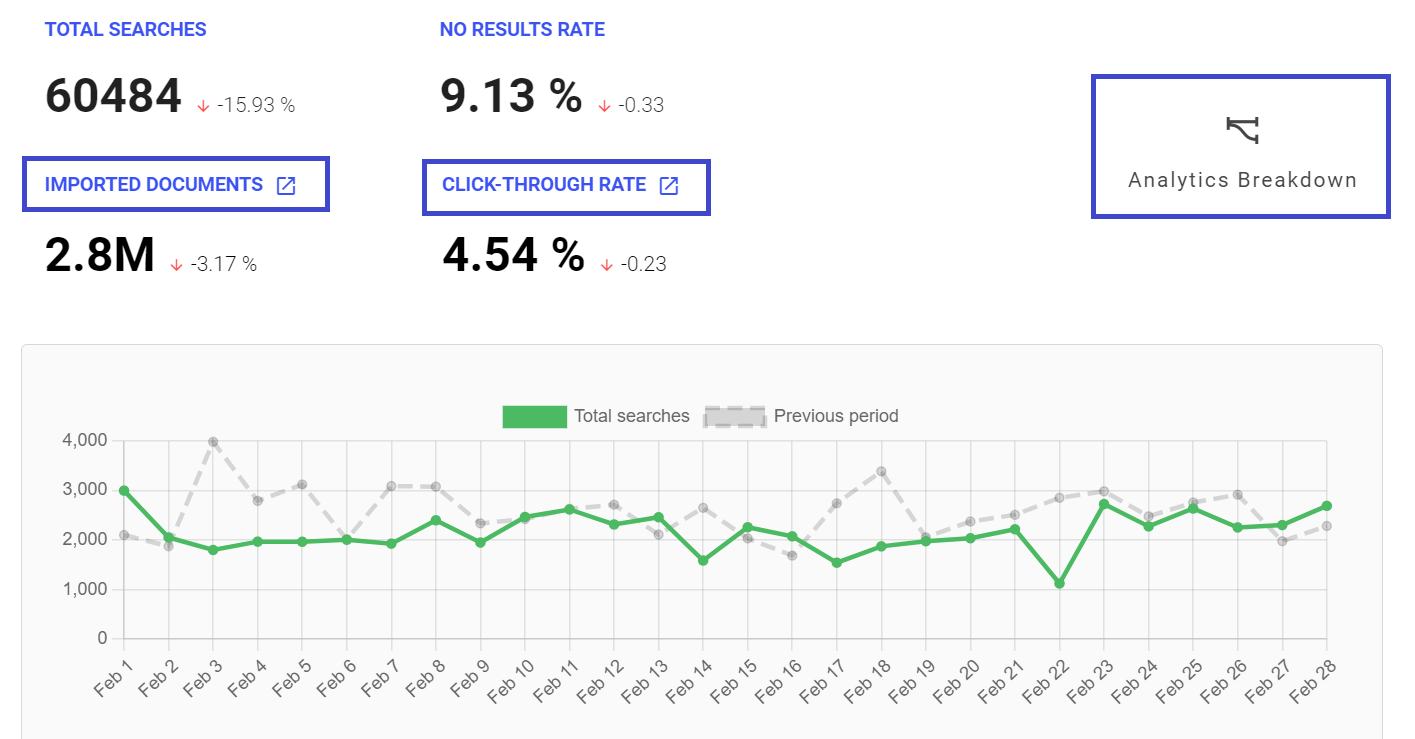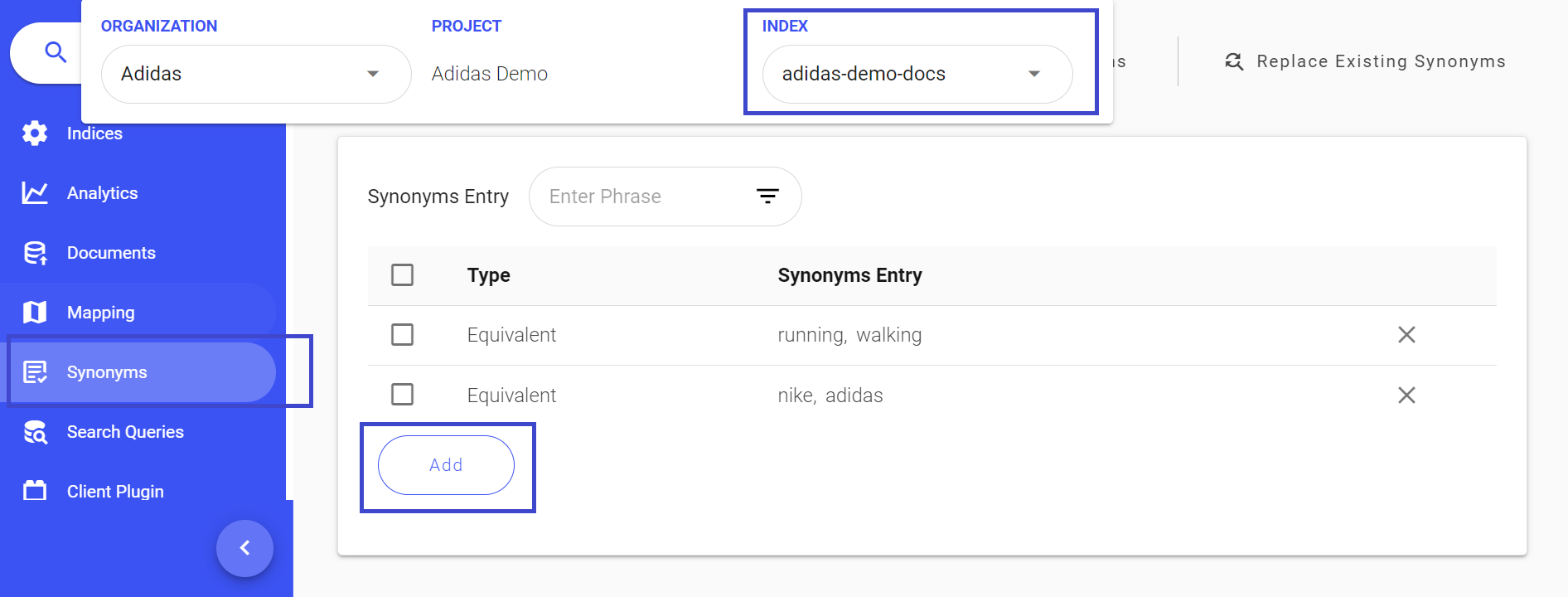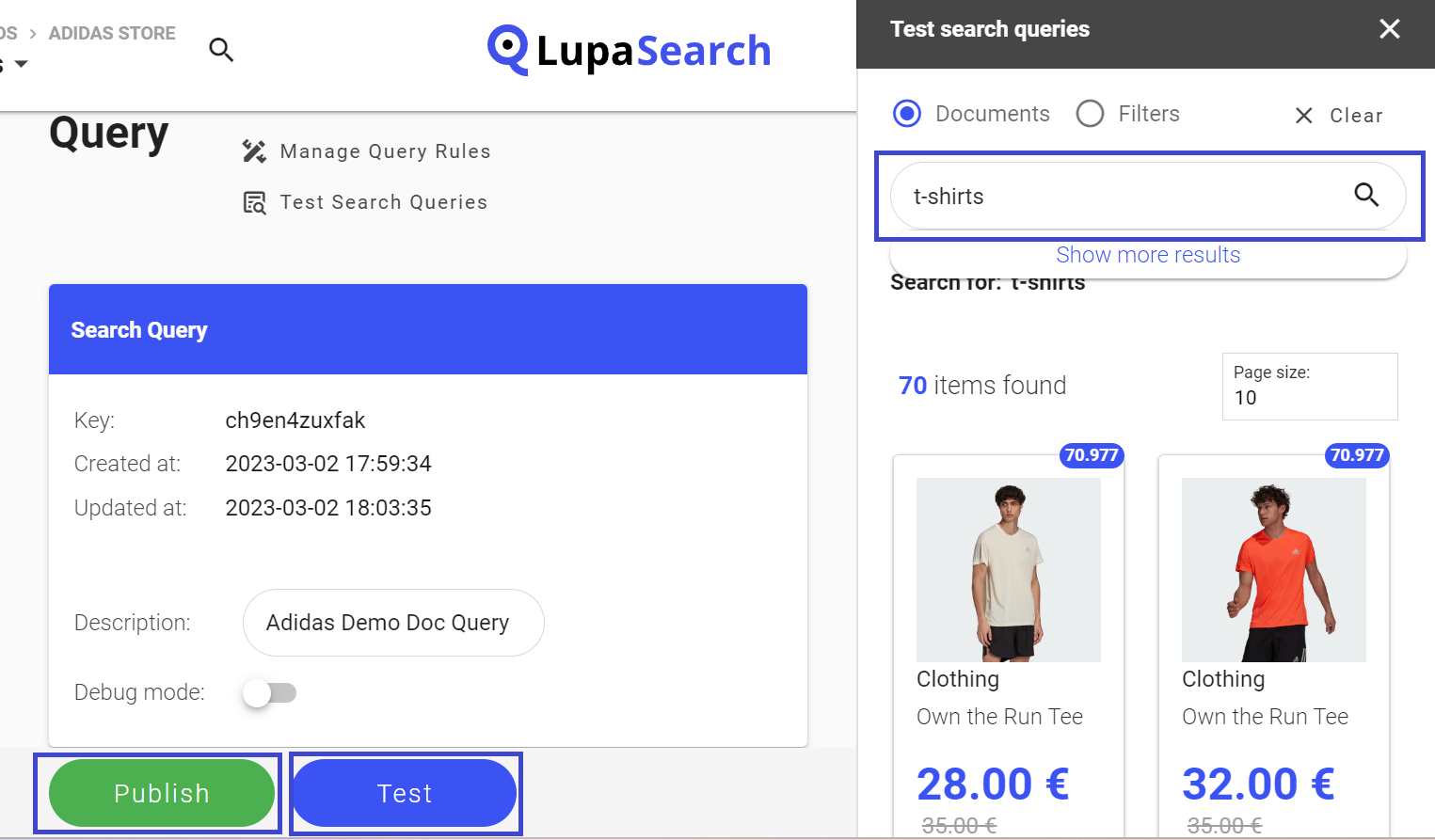Console User Manual
Start using LupaSearch console, analyze how your store visitors interact with the e-shop search, and deliver a convertible user experience.
This user manual provides instructions on how to use a LupaSearch Dashboard.
Follow the information on how it works and use expert insights to improve the search experience of your e-commerce store.

Key definitions
LupaSearch - a highly configurable Software as a Service (SaaS) search engine that delivers real-time search results based on users’ intentions and actions in web applications, including e-commerce stores.
Index - data that search engine refers to when searching for the most relevant results to match the specific query. You can also think of it as a location where all your Documents are stored that serves as a base for the search.
Mapping - a schema that defines the attributes of each field in the Index. That is, how the Documents (and the fields they contain) are stored and indexed. These attributes can be used to configure Search Queries.
Document - any searchable unit that can be queried. Most often, Documents are e-commerce products. You can also use LupaSearch to query other types of units depending on your business needs: product categories, blog posts, tags, documentation, etc.
Search Query - a configuration that describes how data should be queried from your index. For example, you can set query fields, aggregations (facets), initial filtering, sorting rules and many other settings.
Public Query - an execution of your Search Query. Public query expands search query configuration with data that is required to perform a single query, like search text, page number, additional filters and sorting rules.
Synonym - additional search phrases that e-shop administrators can assign to the Documents to improve the search relevance. The terms may contain professional, formal, and culture-specific jargon.
Test your search

Use this section to test your Search and see how it works in real-time before you launch it onto your e-shop.
Pick a Document Query Key and Suggestion Query Key to try out a demo version of your website search. When the product feed loads, start typing in a Search Query into a search field. This section provides the same experience as your website visitor would have.

At the top right, press Configure to set up settings for a search test. Save any applied changes and try out the search.
Analytics
Use this section to see an overview of how relevant your e-commerce store search is and how your website visitors interact with it.
Analyze the metrics frequently to understand how well your e-commerce search is performing.
Make data-driven decisions to update your store and perfectly reflect the users’ search intentions.
At the top right of the page, next to Search Index, select the Index you want to see Analytics for.
Click on the Date Range and pick the days. You will see the Analytics results within the selected period of time.
Filter Analytics results by selecting one relevant key (for instance, Main product search query or Suggestions search query) or all of them in the Search Query dropdown menu.

Total Searches represent the number of times users used a search in your store during the selected date range. This fluctuation of the search numbers is also presented in the chart below, so you can visually see the search trends and identify any radical changes according to days.
No Results Rate displays the percentage of search queries that returned a blank result page (with zero results). This metric shows the numeric discrepancy between what users expect your store to have and what products there are.
Imported documents show the total number of processed products during various search indexing operations - daily product imports, updates and deletions. This information helps to spot any issues or unexpected changes in indexing volume.
Click-through rate tracks the ratio of user engagement events (search result item clicks or adds to cart) and a total number of search queries. It is a very useful tool to track the overall performance of the search settings, as well as to see how various configuration changes affect this metric over time. LupaSearch Analytics also allows to track which of the search terms have the best CTR (i.e. which search terms are driving the highest user engagement) and additionally includes the CTR metric for the most popular queries.
CTR will only be tracked if the project is reporting ‘product click’ and ‘add to cart’ events from the search results page back to the LupaSearch Events API.
The visual chart and these metrics help you understand how well your search serves your website visitors and correlates to their satisfaction.
Above the visual chart, press Analytics Breakdown to expand Total Searches and see results from each Index and Query.

Below the chart, you can see a textual representation of your search performance.

Top Searches reflect the most searched terms (and the number of repetitions). Use this data to understand what your users are most interested in, and rank search results accordingly to boost sales and generate top value.
Popular Suggestions - the most suggested terms for users when they were typing words into a search bar. These suggestions are selected according to their relevance to the user and appear at the top of the suggestions list. You can always modify the suggestions - the results in the Popular Suggestions section will change over time accordingly.
Searches Without Results - displays the number and searches that returned a zero result page. Use the data from zero results queries to update and include more synonyms to your products (if applicable) or identify significant lost opportunities. This section is a valuable source of information for planning product assortment expansion and business growth.
Documents
Document Import allows you to conveniently import your Documents (Items/Products entries) directly into the Lupa dashboard. The Dashboard document import functionality is intended for preview/development or debugging purposes. For Production implementations, please use the API.
The Document is any searchable unit that can be queried. Usually, documents are your products. Yet, you can use LupaSearch to store and query product categories, tags, blog posts, documentation, and any other object required for your website.
To format your Documents correctly, follow the instructions in the Documentation section -> Documents.
Mapping
Mapping is usually set up by the LupaSearch team.
Mapping defines how your products (or other relevant searchable objects) are stored and indexed. You do not need to describe all attributes of your dataset. Make sure to define attributes you want to use later in the search configuration. You can add various attributes like text, numeric, and other data types.
Consult with LupaSearch product consultants if you have any questions or concerns regarding effective mapping. Of course, you can always set it up on your own. Find out instructions in the Documentation section -> Search Indices -> Mapping.
Synonyms
Synonyms are the feature that enables the search engine to create equivalences among different search queries. Even if your product feed does not include all possible search query variations, you can link groups of words to each other as synonyms.
When a user searches for a product in his own words, the Synonym feature will return the result of an equivalent product. (For instance: “trousers” = “leggings”; “shoes” = “boots”, “cake” = “pie”, etc.)
You can add synonyms in a context of a search index.

Click Append New Synonyms to upload bulk synonym entries from a text file directly through the dashboard. The dashboard allows listing, filtering, deleting, and adding new synonym entries.

Alternatively, you can add synonyms using the API. Follow the instructions in the Documentation section -> Search Indices -> Synonyms.
LupaSearch allows adding two types of synonyms: equivalent and directional.
Equivalent synonyms - add similar words or phrases with similar meanings according to the context of the products in your e-shop. Consider these synonyms as interchangeable words that do not change the meaning radically.
For instance, if you add the words small, little, miniature, narrow, and short as synonyms, the user query "small fridge" would match products with names like:
small fridge;
fridge - short;
narrow, compact fridge.
Similar results would still be present for similar user queries, like a little fridge or miniature fridge. However, exact matches (like a small fridge in the example above) will always be displayed at the top of the search results, unless these rules are overridden with your custom query boosting.
Directional synonyms - add jargon and slang words or phrases that your potential buyers would use to call the products (but you would not add them to the product feed). These synonyms are applied one way only and override the jargon words.
For instance, if you add “kicks” as a directional synonym, it would match the user entries like:
shoes;
sneakers.
However, the search query "sneakers" would never return results with slang or jargon words (that are not formally used to call the product). Therefore, consider directional synonyms as a one-way synonym replacement.
Search Queries
The Search Queries section allows you to describe and configure different ways data on your index can be queried.
Click Create New to set up a new Search Query. Follow the instructions next to each configuration setting.

Once you finish setting up a new Search Query, click the Test button to test your search before submitting changes to the live version of the e-shop. Click Publish to commit changes from the test version to the live version.

Under Actions, select the pen icon to access the Search Query configuration.
In this section, you can customize search results: boost specific products (like the most profitable ones), rank products according to specific needs (categories, brands, discounts, etc.), filter some products out (like excluding alcoholic beverages from search results), and others.
- Note: in some countries, product ranking and boosting requires providing a disclaimer for website visitors. Always check the laws of your country and describe your website's search engine operation in a legally correct manner.
Once you finish customizing your Search Queries, click the Test button to test your search before submitting changes to the live version of the e-shop. Click Publish to commit changes from the test version to the live version.
Under Actions, select a pen and ruler icon to create rules for your Search Queries. These rules would override default settings based on user input, current date, or other conditions.
For example, you can create a rule to show only the most popular products if a user enters an empty query.
Use this feature to customize the search to generate the top value.
Under Actions, select a recycle bin icon to delete a Search Query.
Client plugin
Client plugin is an option for those who want a quick e-commerce search integration with fewer customization options. It is a plugin with search pop-up and a clean, default interface. It can be integrated by adding just one script - no need to invest in complex integration or custom solutions. The plugin supports main LupaSearch features and works on desktop and mobile.
Contact information
In case you have any questions, reach out to us at [email protected]. The LupaSearch team will happily assist you.